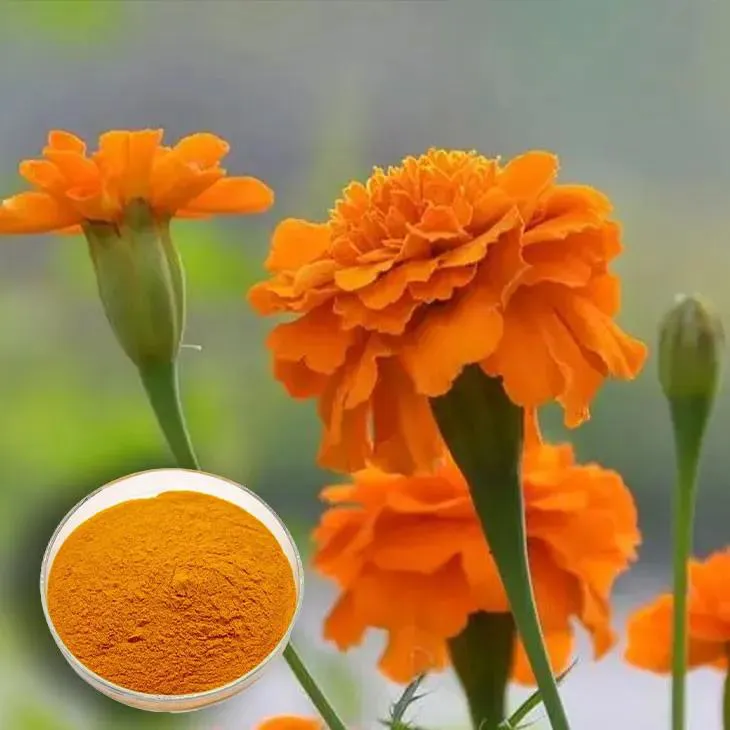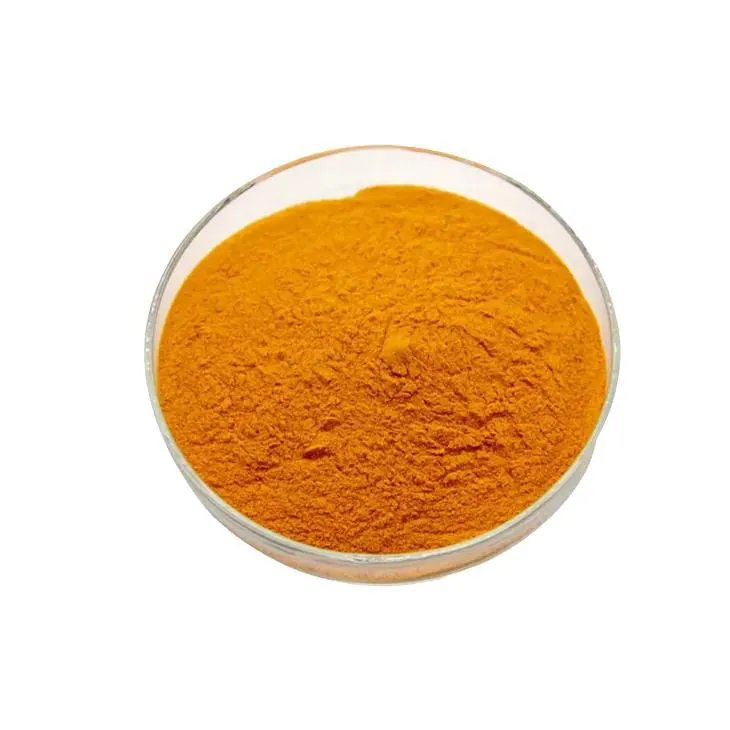- 0086-571-85302990
- sales@greenskybio.com
Extraction process of marigold extract.
2024-11-28

1. Introduction
Marigold is a remarkable plant that has drawn significant attention in the field of extraction due to its rich and unique chemical composition. The Marigold Extract obtained from this plant has a wide range of applications in various industries, especially in the nutraceutical and cosmeceutical industries. Understanding the extraction process of Marigold Extract is crucial for harnessing its full potential.

2. Collection of Marigold Specimens
2.1 Selection Criteria
The first step in the extraction process is the collection of marigold specimens. It is essential that these specimens are in prime condition. Prime - quality marigolds are typically fully developed, healthy, and free from diseases or pests. The time of collection also plays a vital role. Marigolds are usually collected when they are in full bloom as this is when the concentration of the desired compounds is likely to be at its highest.2.2 Harvesting Methods
When harvesting marigolds, gentle methods should be employed to avoid damaging the flowers. Manual harvesting is often preferred as it allows for the selection of only the suitable flowers. Tools such as scissors or small pruning shears can be used to carefully cut the flower heads from the plants.
3. Preparation for Extraction
Once the marigold specimens are collected, they need to be prepared for extraction.
3.1 Cleaning
The first step in preparation is cleaning. The marigold flowers should be carefully cleaned to remove any dirt, debris, or other contaminants. This can be done by gently rinsing the flowers with clean water. However, care must be taken not to soak the flowers for too long as this may cause the loss of some water - soluble compounds.3.2 Drying
After cleaning, the marigolds may need to be dried. Drying helps to reduce the moisture content in the flowers, which can be beneficial for the extraction process. There are different methods of drying, such as air drying and oven drying. Air drying is a more natural method where the flowers are spread out in a well - ventilated area and allowed to dry slowly. Oven drying, on the other hand, is a faster method but requires careful control of the temperature to avoid overheating and damaging the flowers. The ideal drying temperature for marigolds is usually around 40 - 50°C.
4. Extraction Methods
4.1 Maceration
One of the key extraction methods is maceration. In this process, the marigold material (either fresh or dried) is crushed into smaller pieces. This increases the surface area available for extraction. The crushed marigold is then mixed with a suitable solvent. Suitable solvents for Marigold Extraction include ethanol, hexane, and ethyl acetate. The mixture is then left for a long time, usually several days to weeks. During this time, the solvent penetrates the marigold tissue and dissolves the target compounds. The longer the maceration time, the more complete the extraction is likely to be. However, very long maceration times may also lead to the extraction of unwanted compounds.4.2 Soxhlet Extraction
Another important extraction method is Soxhlet extraction. This is a continuous extraction process that is highly efficient for extracting components from marigold. In a Soxhlet extractor, the marigold sample is placed in a thimble. The solvent is then heated and vaporized. The vapor rises and condenses in a condenser, and the condensed solvent drips back onto the marigold sample in the thimble. This continuous cycle of solvent evaporation, condensation, and dripping back onto the sample ensures that the target compounds are continuously extracted from the marigold. Soxhlet extraction is often preferred when a more complete extraction is required, especially for extracting less - soluble compounds.
5. Purification of Marigold Extract
After the extraction process, the marigold extract obtained usually contains a mixture of compounds, including the target compounds as well as some impurities. Therefore, purification steps are necessary.
5.1 Chromatography Techniques
Chromatography techniques are widely used for the purification of marigold extract. Chromatography is based on the principle of differential migration of compounds in a mobile phase and a stationary phase. For marigold extract purification, techniques such as high - performance liquid chromatography (HPLC) and thin - layer chromatography (TLC) can be used.- In HPLC, the marigold extract is injected into a column filled with a stationary phase. A liquid mobile phase is then pumped through the column at a high pressure. The different compounds in the extract move through the column at different rates depending on their affinity for the stationary and mobile phases. This allows for the separation and purification of the target compounds.
- TLC is a simpler and more cost - effective chromatography method. A thin layer of a stationary phase is coated on a plate. The marigold extract is spotted on the plate, and a solvent (mobile phase) is allowed to move up the plate by capillary action. The different compounds in the extract separate as they move up the plate at different rates. The purified compounds can then be isolated from the plate.
6. Applications of Marigold Extract
Once the marigold extract is purified, it can be utilized in different fields.
6.1 Nutraceutical Industry
In the nutraceutical industry, marigold extract is rich in compounds such as lutein and zeaxanthin, which are beneficial for eye health. These compounds can be incorporated into dietary supplements in the form of capsules, tablets, or powders. They are known to help prevent age - related macular degeneration and cataracts.6.2 Cosmeceutical Industry
In the cosmeceutical industry, marigold extract has antioxidant and anti - inflammatory properties. It can be used in skin care products such as creams, lotions, and serums. Marigold extract can help to improve skin hydration, reduce wrinkles, and soothe irritated skin.7. Conclusion
The extraction process of marigold extract is a complex but well - defined process. From the collection of prime - quality marigold specimens to the final purification of the extract, each step plays a crucial role in obtaining a high - quality marigold extract that can be used in various industries. Continued research in this area may lead to further improvements in the extraction process and the discovery of new applications for marigold extract.
FAQ:
What are the main methods for marigold extract extraction?
The main methods for marigold extract extraction include maceration and Soxhlet extraction. In maceration, the marigold material is crushed and mixed with a suitable solvent for a long time. Soxhlet extraction is a continuous extraction process that can efficiently extract the components from marigold.
Why is it important to use specimens in prime condition for marigold extract extraction?
Using specimens in prime condition is important for marigold extract extraction because the quality of the specimens directly affects the quality and quantity of the extract. Prime - condition specimens are more likely to contain a higher concentration of the desired compounds, which can lead to a more effective extraction process and a higher - quality final extract.
What is the role of purification steps in the extraction of marigold extract?
The purification steps in the extraction of marigold extract are crucial as they help to separate and purify the extract. Chromatography techniques are often used in these purification steps. By purifying the extract, its quality is ensured, which makes it suitable for use in various industries such as the nutraceutical and cosmeceutical industries.
How does chromatography help in purifying marigold extract?
Chromatography helps in purifying marigold extract by separating the different components present in the extract based on their chemical properties. This allows for the isolation of the desired compounds and the removal of impurities, resulting in a more pure and high - quality marigold extract.
What are the potential applications of marigold extract?
Marigold extract has potential applications in different fields. In the nutraceutical industry, it can be used for its potential health - promoting properties. In the cosmeceutical industry, it can be used in products such as skincare and haircare products due to its beneficial effects on the skin and hair.
Related literature
- Extraction and Characterization of Marigold (Tagetes erecta L.) Pigments"
- "Optimization of Marigold (Tagetes erecta L.) Extract Production for Cosmetic Applications"
- "Marigold Extract: A Promising Ingredient in Nutraceuticals"
- ▶ Hesperidin
- ▶ Citrus Bioflavonoids
- ▶ Plant Extract
- ▶ lycopene
- ▶ Diosmin
- ▶ Grape seed extract
- ▶ Sea buckthorn Juice Powder
- ▶ Fruit Juice Powder
- ▶ Hops Extract
- ▶ Artichoke Extract
- ▶ Mushroom extract
- ▶ Astaxanthin
- ▶ Green Tea Extract
- ▶ Curcumin
- ▶ Horse Chestnut Extract
- ▶ Other Product
- ▶ Boswellia Serrata Extract
- ▶ Resveratrol
- ▶ Marigold Extract
- ▶ Grape Leaf Extract
- ▶ New Product
- ▶ Aminolevulinic acid
- ▶ Cranberry Extract
- ▶ Red Yeast Rice
- ▶ Red Wine Extract
-
Milk Thistle Extract
2024-11-28
-
Hawthorn Extract
2024-11-28
-
Camu Camu Extract
2024-11-28
-
Aguaje Extract
2024-11-28
-
Cat Claw Extract
2024-11-28
-
Sophora Flavescens Root Extract
2024-11-28
-
Europen Bilberry Extract
2024-11-28
-
Reishi mushroom extract
2024-11-28
-
Grape Seed Extract
2024-11-28
-
Red Vine Extract
2024-11-28





















